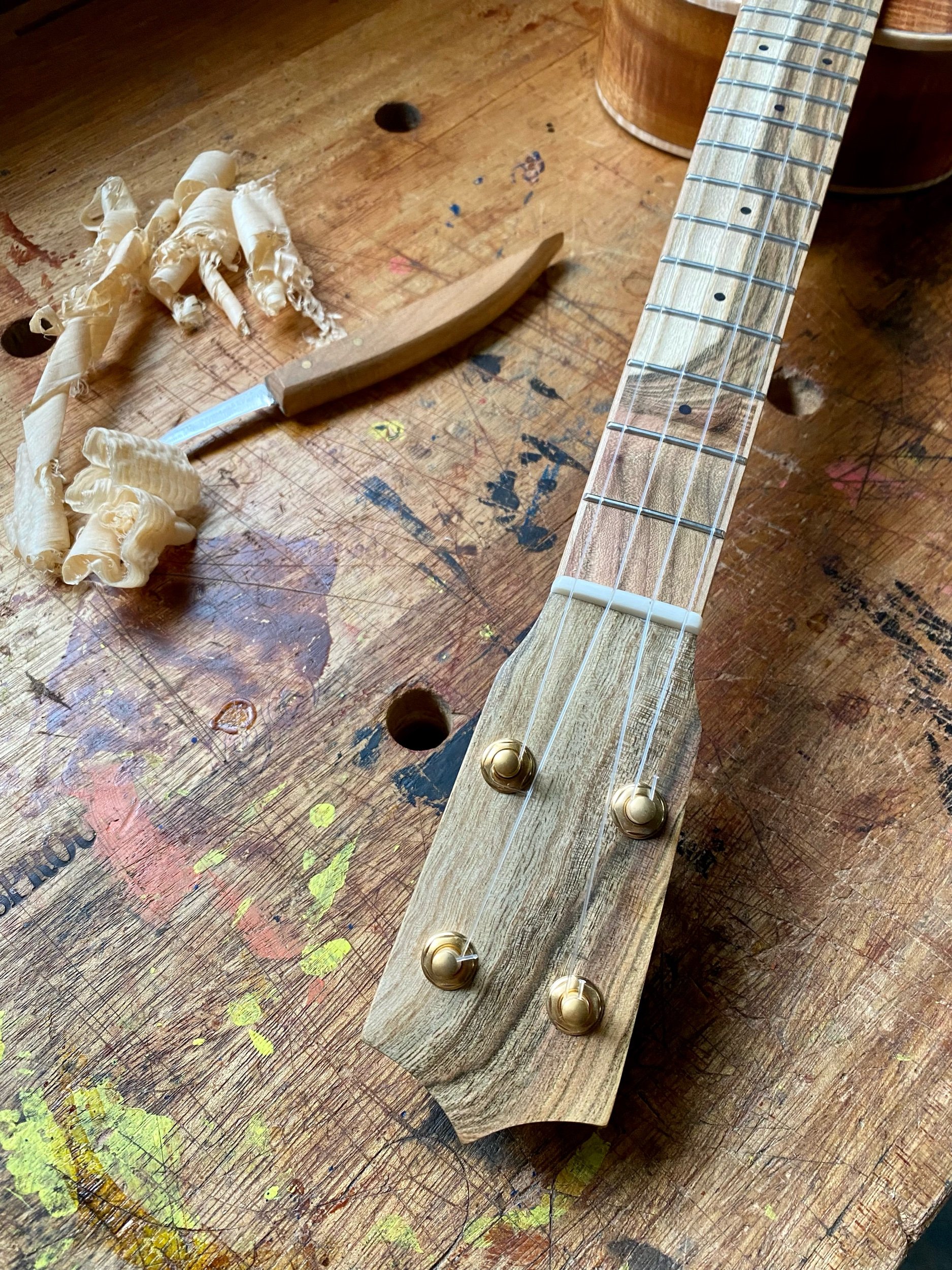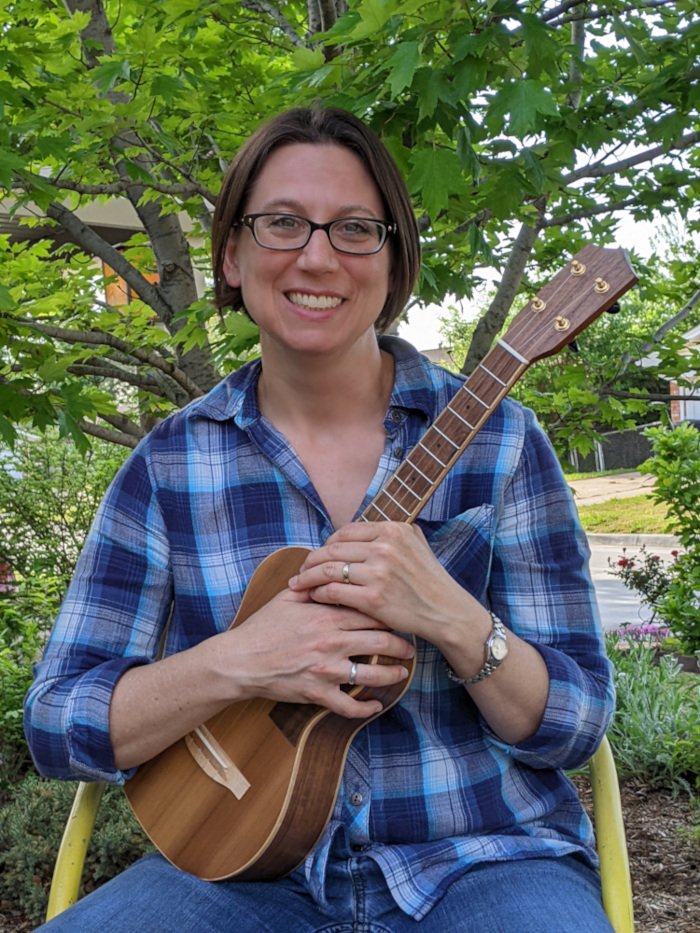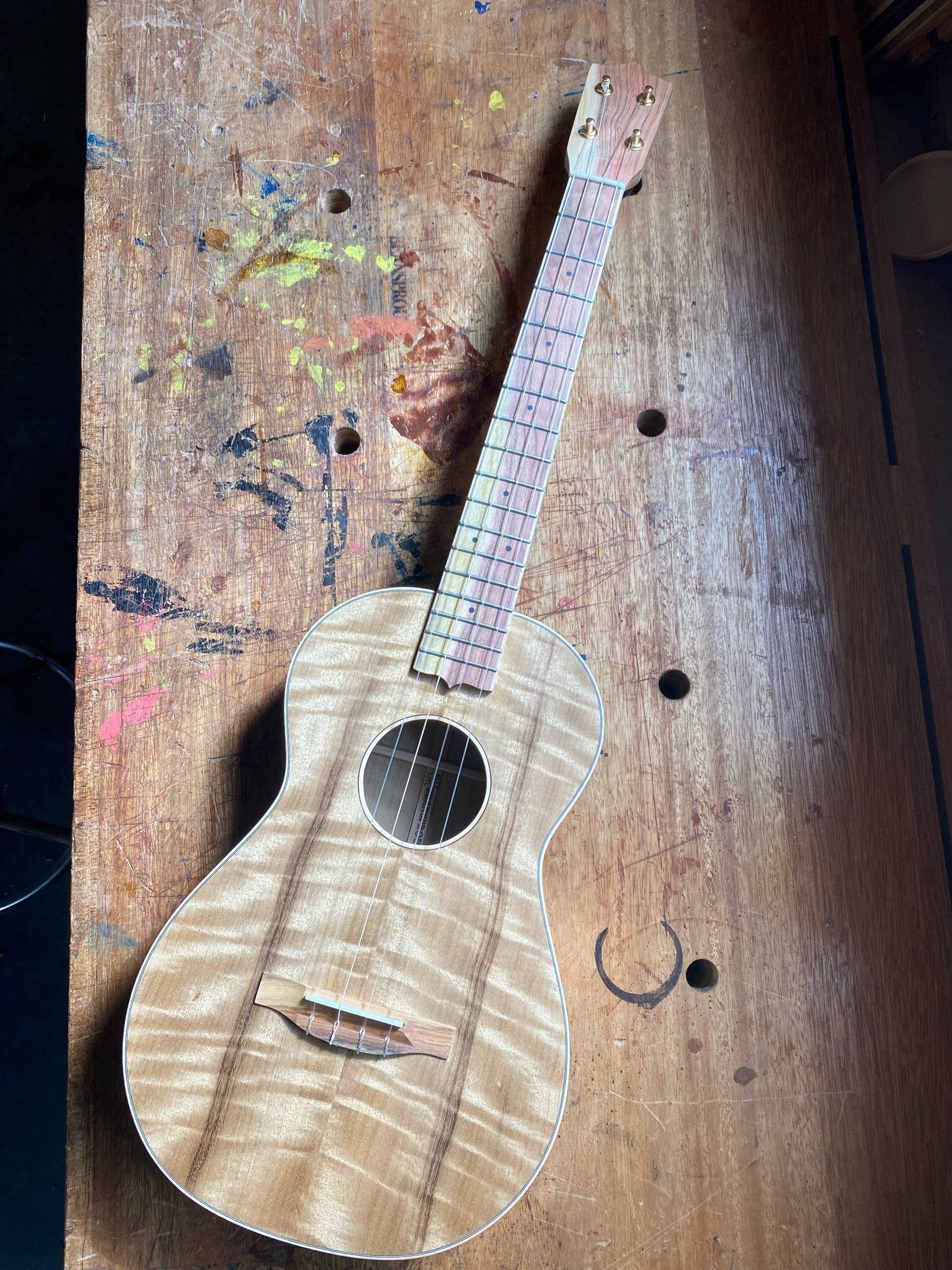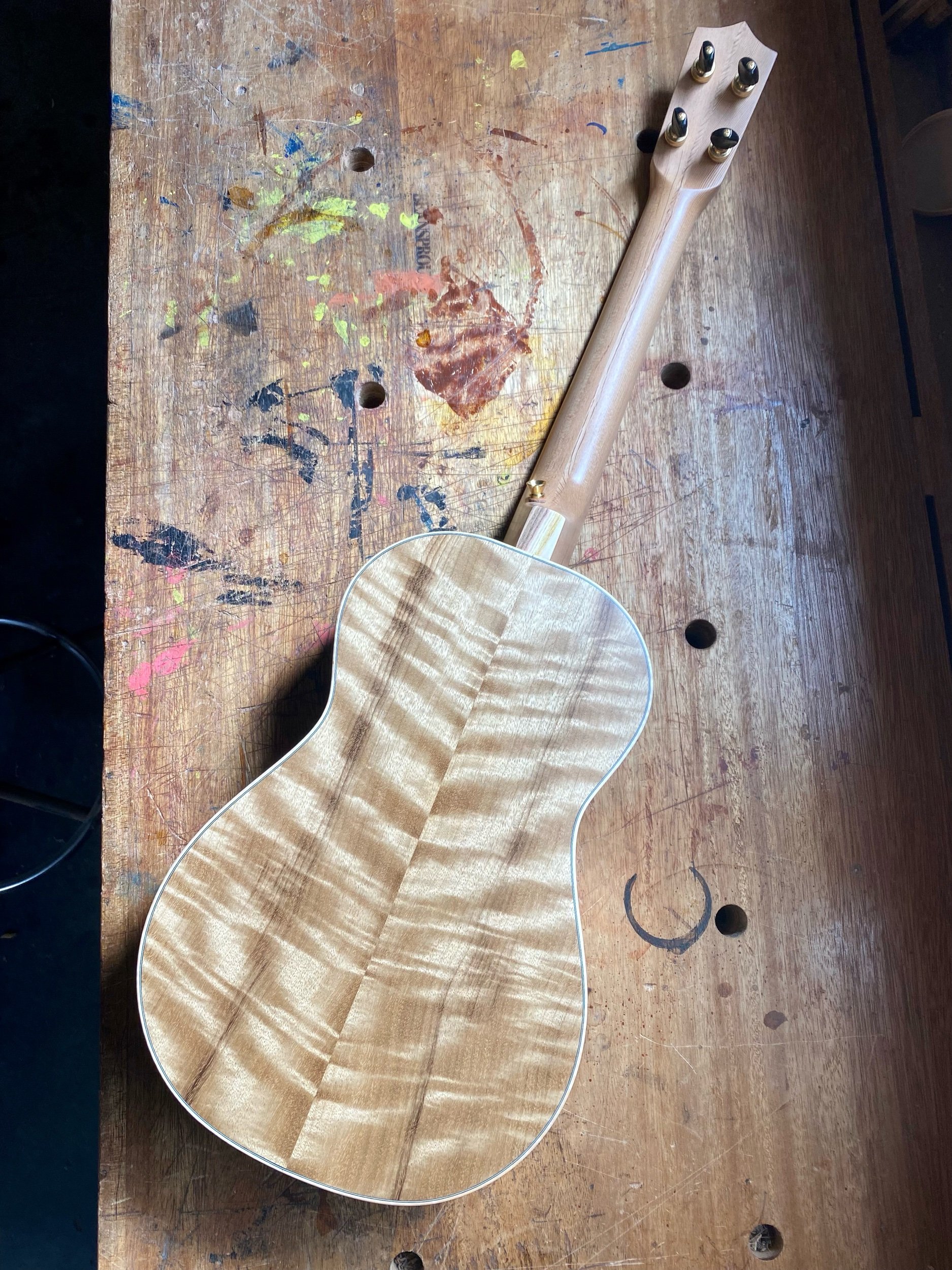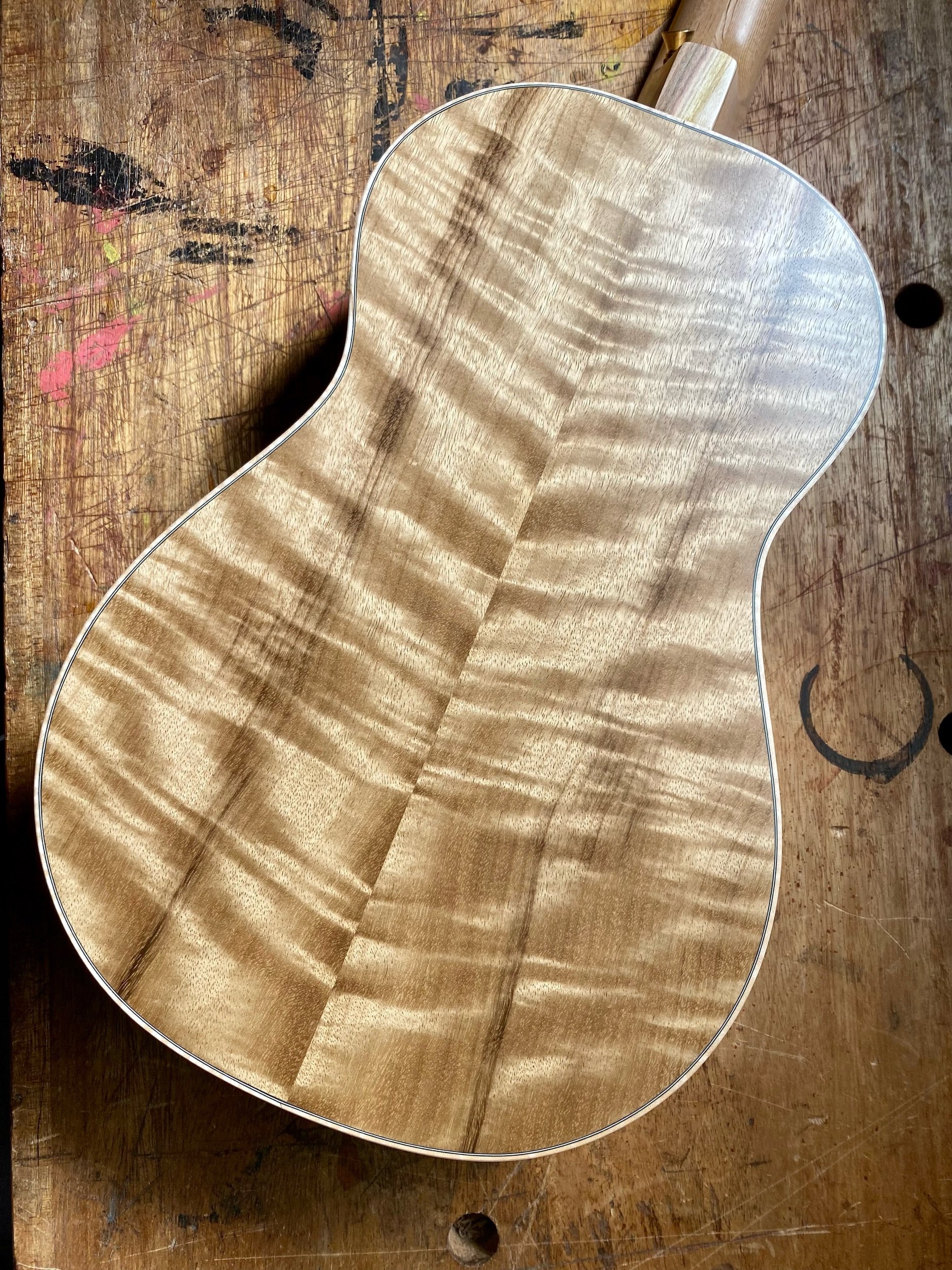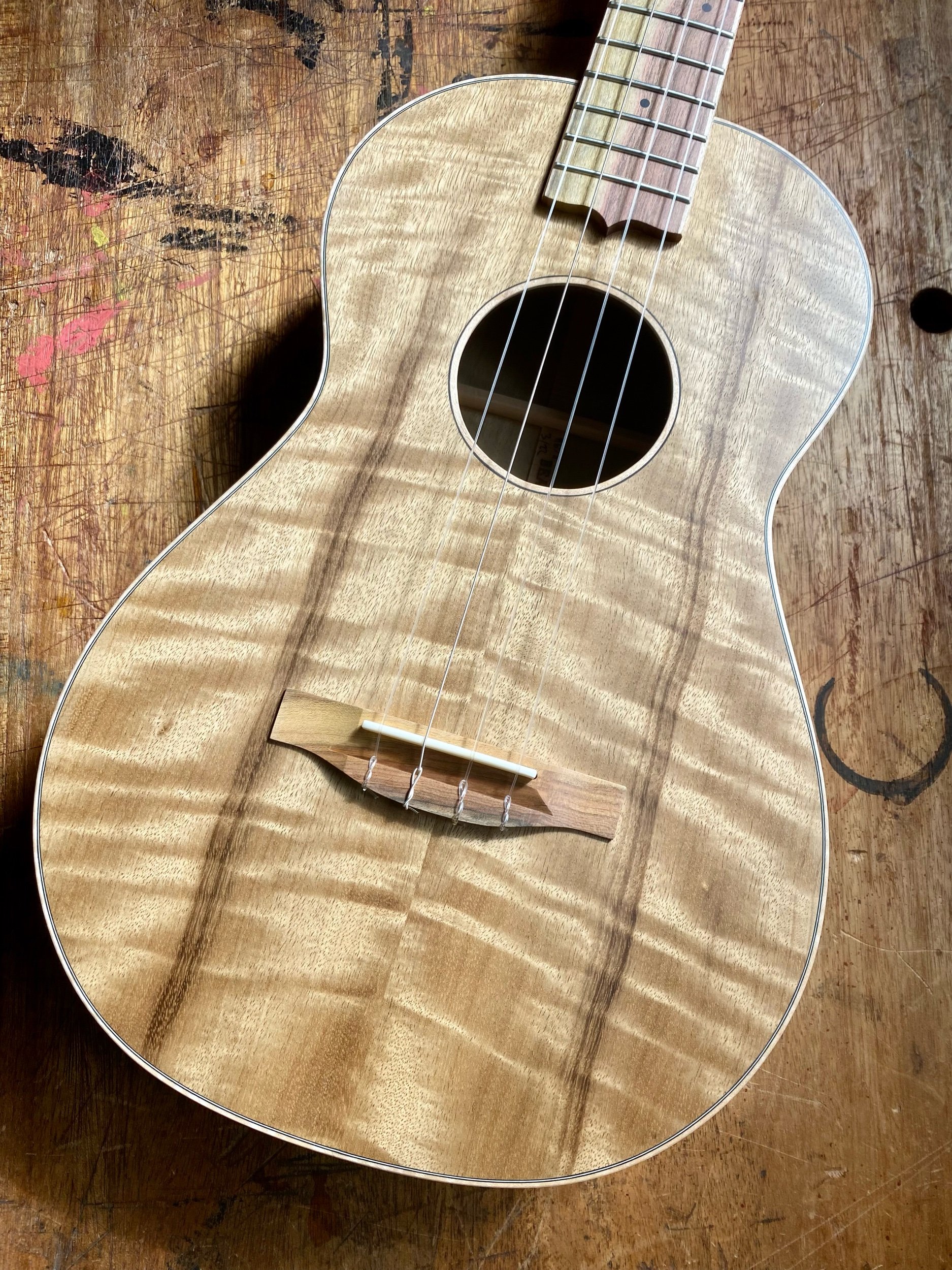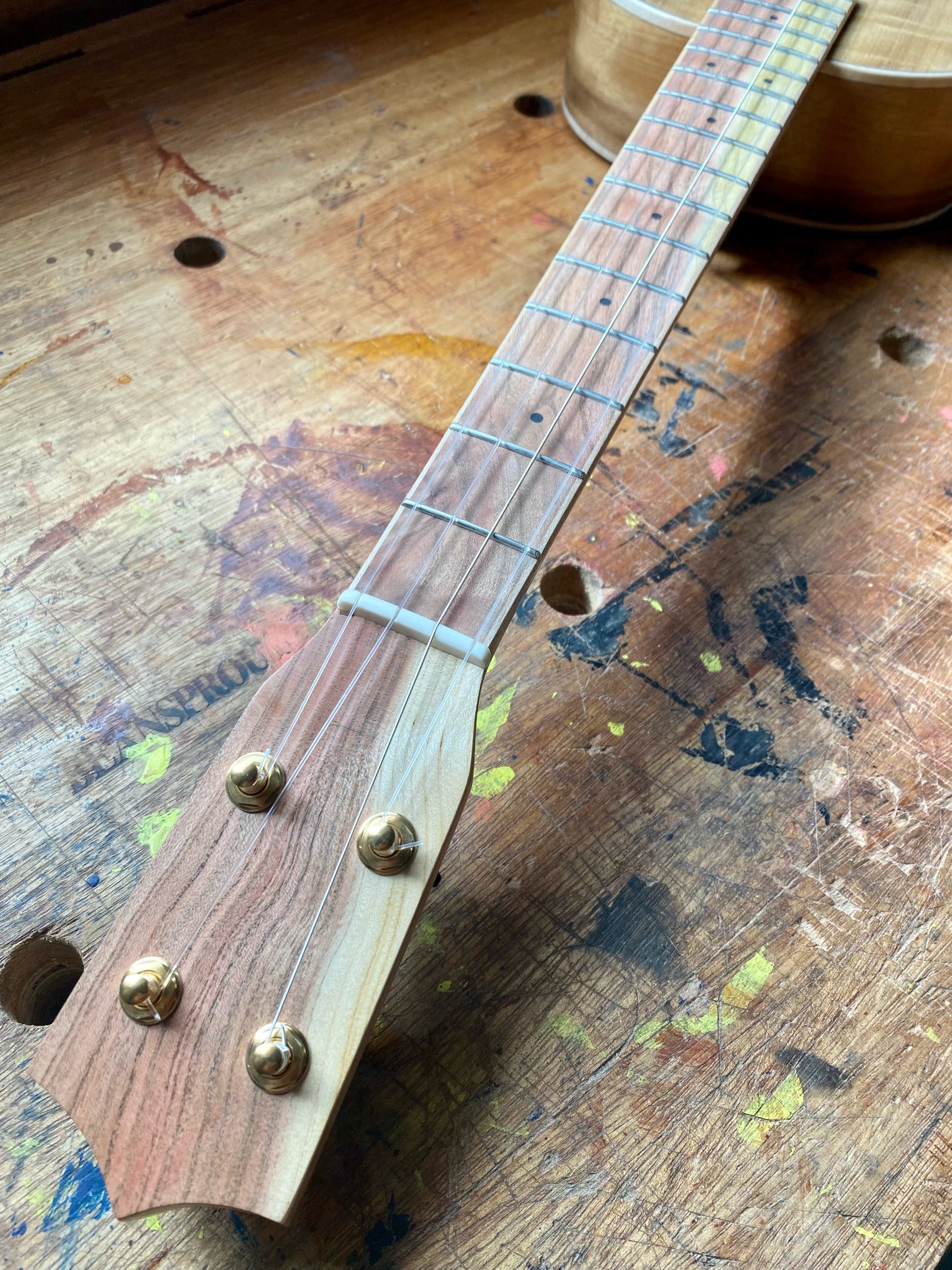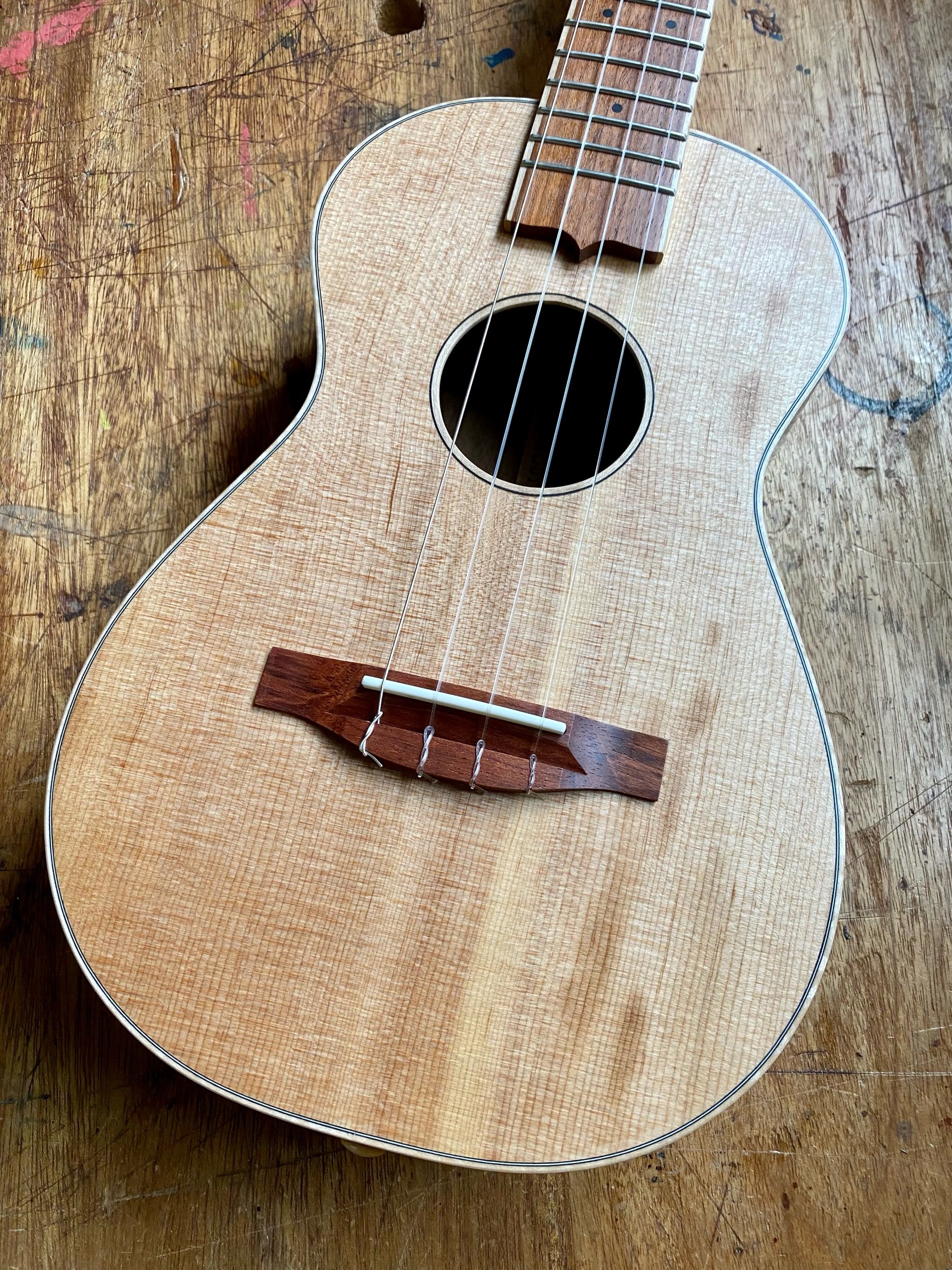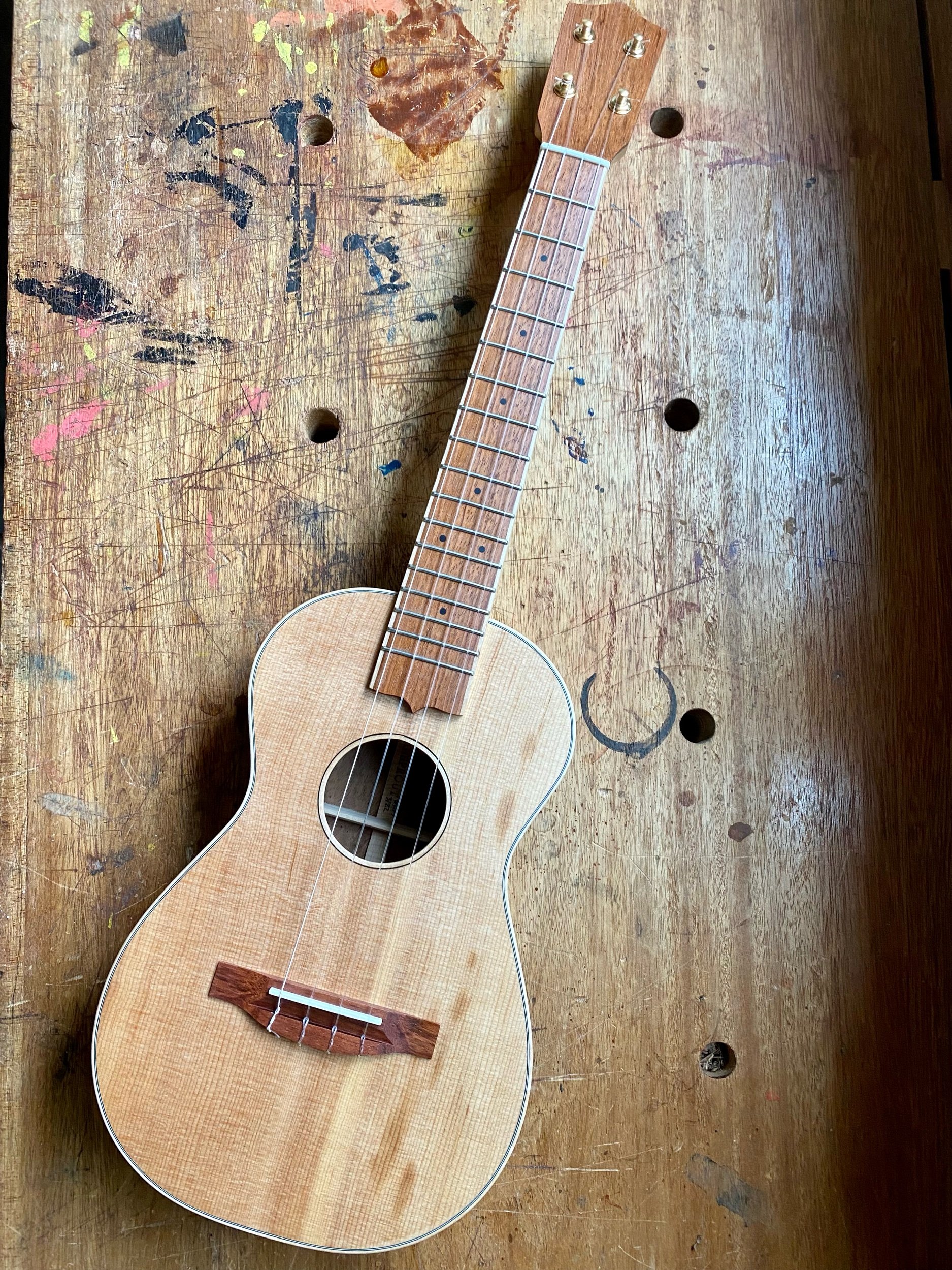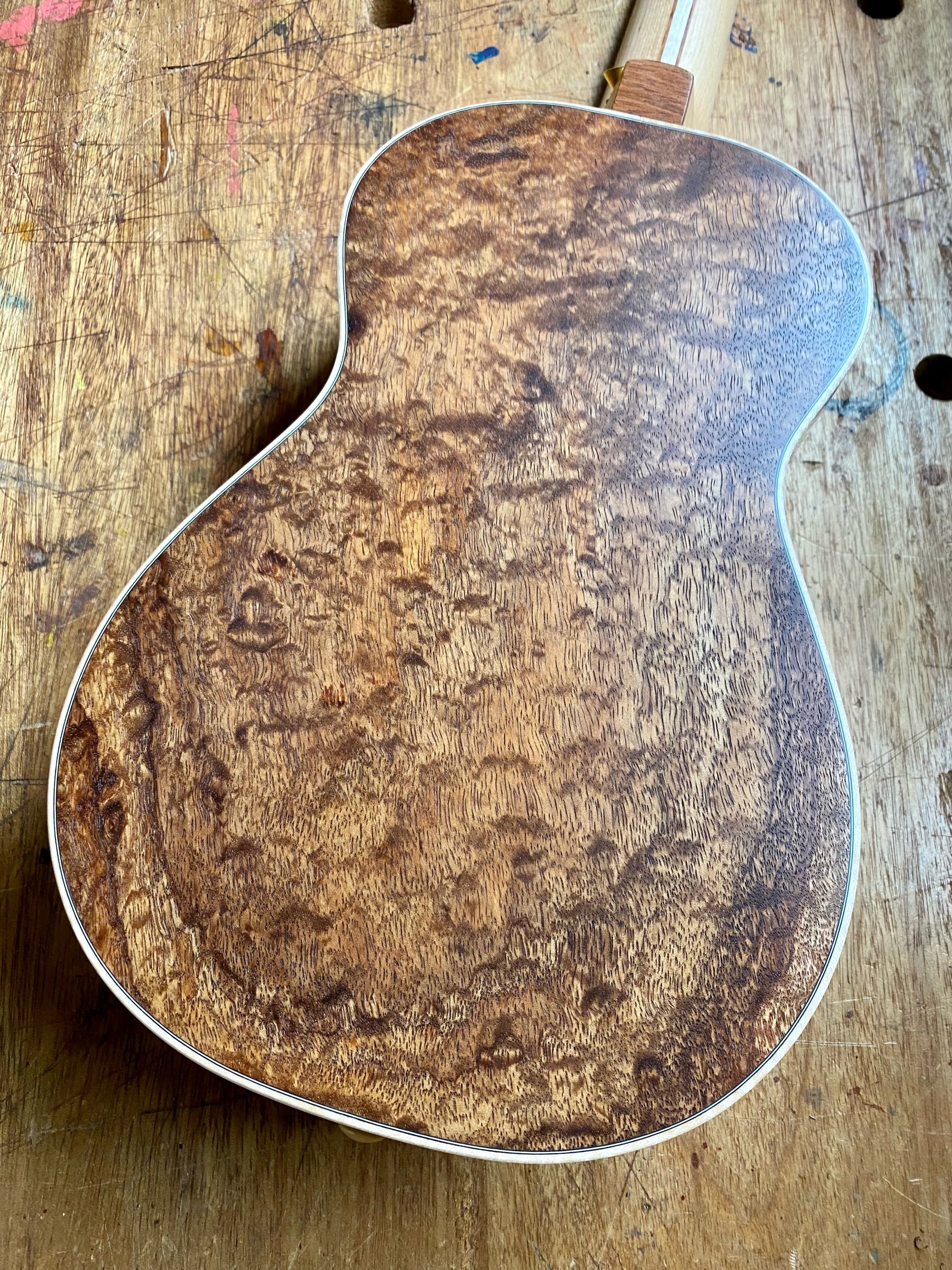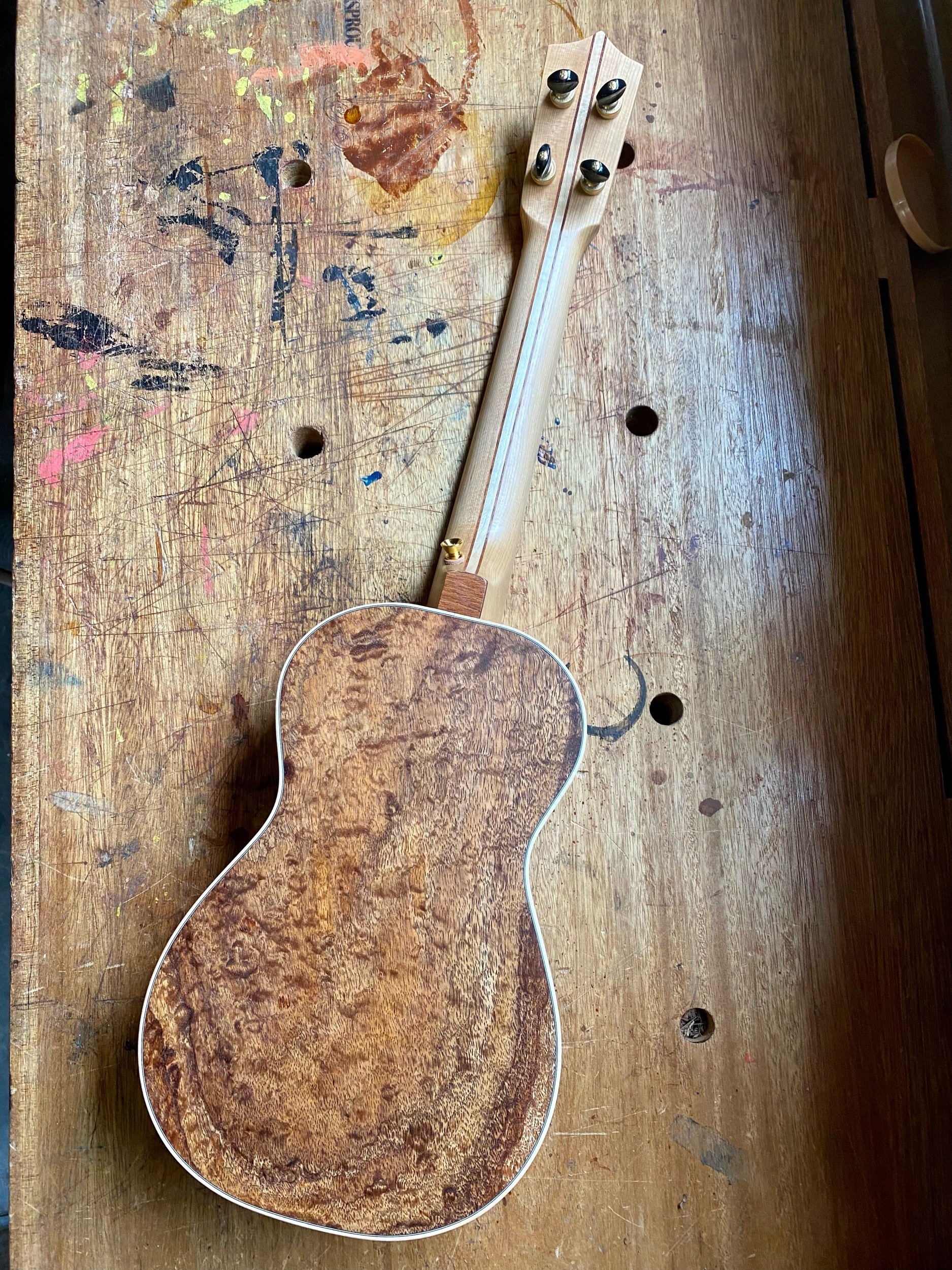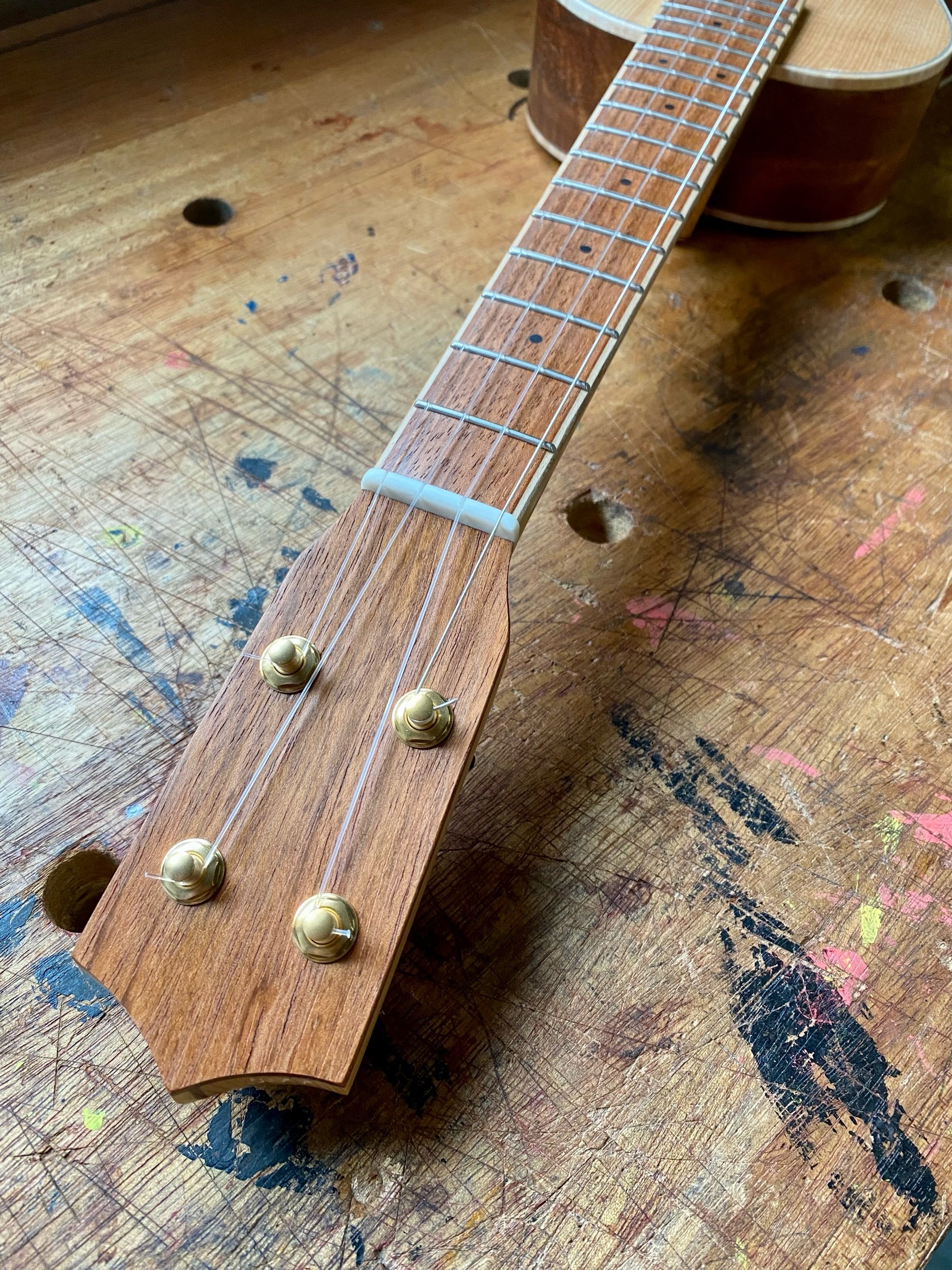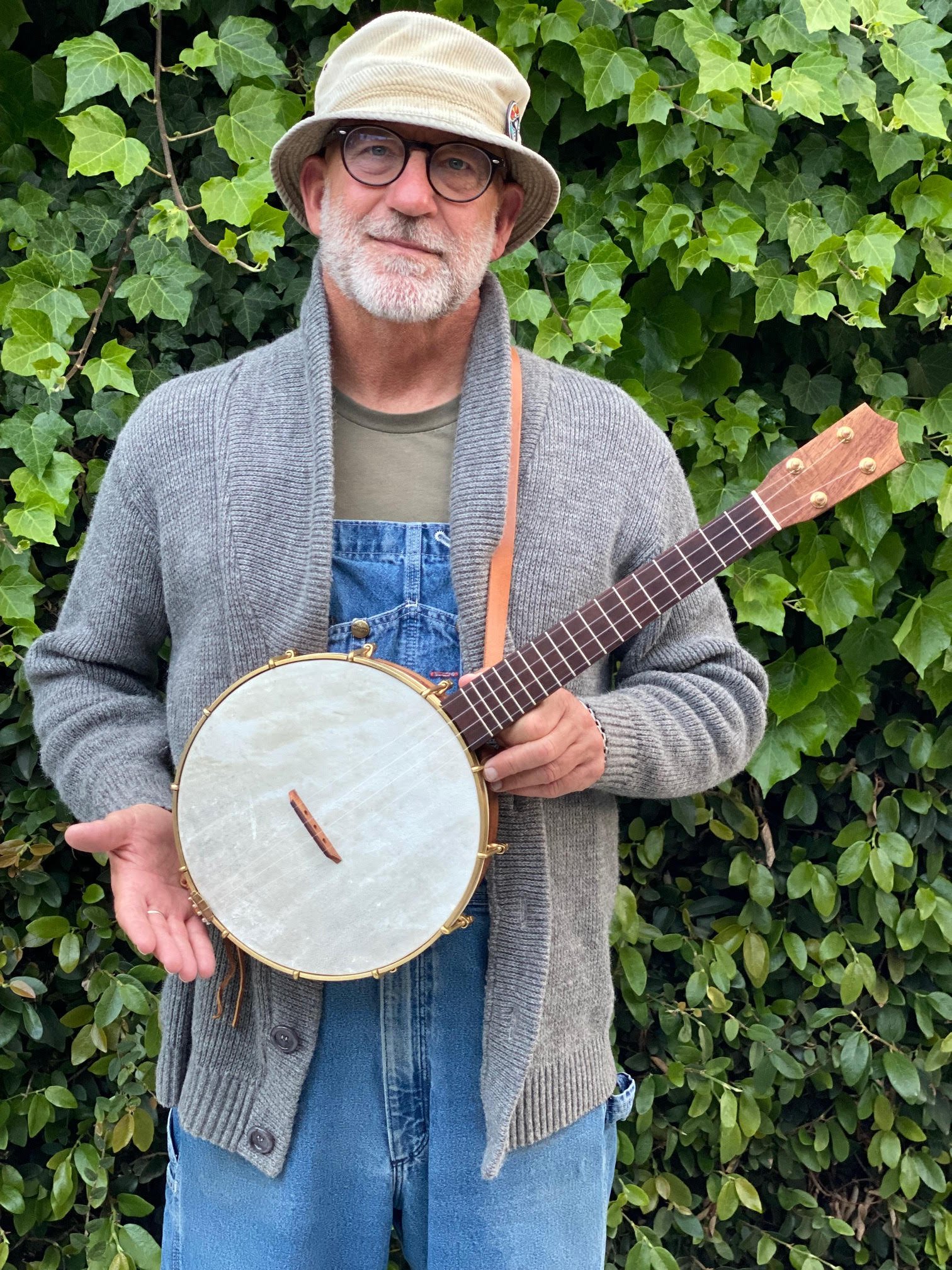Cedar and Walnut has been a popular combination lately and I’m not really surprised. It’s local, readily available, looks nice and sounds lovely. Dark, rich, expressive but with a little sparkle to the tone. This alto with a low G doesn’t disappoint. The walnut is from guitar maker Ben Bonham, who passed on these ukulele sized pieces of local timber. I used tiny maple dowels to fill a few bug holes. The cypress neck is salvaged from a factory, complete with knots and a nail hole. Walnut also looks nice as the fretboard and headplate. The cedar comes from an old hot tub!
#689- Port Orford Cedar and Curly Walnut Tenor Ukulele
Classic Beansprout: domestic woods, muted/natural color palette, easy playability and big sound. I love it. The one piece Port Orford Cedar top and Pistachio fretboard/headplate come from our friends at woodfromthewest.com. The curly Walnut back and sides are from luthier Jayson Bowerman and the Spruce neck is from luthier Craig Wilson. Thanks, friends! I love the green Myrtle binding with no black lines, purfling a or veneers, it gives a muted/natural look to the whole thing.
“Hey Aaron and Nicole,
Just wanted to let you know the ukulele arrived safe and sound. I’ve had a few days to play her and she sounds perfect. Great tone, and the radiused fretboard is a treat I’ve never had. Obviously the wood is stunning as well.
Thank you so much for the time and effort put into creating this beautiful instrument. It’s more than I ever dreamed!
- B. T. ”
#687- Curly Mahogany Tenor Guitar
This instrument is based off of an old Regal tenor guitar that my friend Geoff Davis has. I traced it and studied it over a glass of wine a few years ago and I decided to build one. The Regal design is nice because it is balanced, comfortable and confident in its smallness. (Other tenor guitars try to hard to be like their big brothers, I think.)
It’s not really louder than one of my ukuleles, just different. I like this all Mahogany one and I also like them with a spruce top.
The curly Mahogany was scrap from another builder, the Spanish Cedar neck and Texas Ebony fretboard/headplate are from a retired banjo builder. The rope binding and brass fittings seal the deal.
“Aaron, Nichole, and Henry:
I received the instruments yesterday. They are incredible! Thank you for the amazing work you put into these and all your instruments. It is such a joy to play them and I thoroughly enjoy your process and documentation of the builds.
The beautiful woods on the tenor guitar are breathtaking! It looks and sounds so, so good. I’ve got a song I look forward to recording on that guitar in the next few weeks.
I really can’t believe how much life you built into the tone of the soprano uke. You have a real gift, Aaron. Thank you for all that you and your family are doing. You are such a positive contribution to the musical community.
I look forward to many years of enjoying these instruments.
Have a great day,
C.P. ”
#686- Curly Mahogany Soprano Ukulele
This instrument is part of a set with a matching tenor guitar, #687. As always, I’m trying to balance the best of ukulele tradition with my own ideas. This one has a slightly wider fretboard by customer request and I find it very easy to play. The curly Mahogany is from a guitar builders scrap pile and the Spanish Cedar neck and Texas Ebony fretboard are from a retired banjo builder. The sound is warm, but percussive, just what I would want with a soprano.
#690- Mastergrade Koa Tenor Ukulele
Koa is the not the loudest wood, but it has a presence and tone that is always pleasing to me. Maybe it’s just because of it’s history as “the” ukulele wood, the many years we have spent hearing Koa and admiring its beauty. I’ve been playing this one for a few days and have come to appreciate the tone as it “wakes up.”
The Koa from this build came from Notable Woods, where Bruce works hard to produce tonewood from salvaged and renewable sources. The Pistachio fretboard/headplate/bridge are from California orchards. The Mahogany neck was salvaged from a cabinet shop scrap bin.
#688- Cedar and Walnut Tenor Ukulele
This project started when our customer sent us a walnut board- salvaged from a stereo cabinet her late father built in high school shop class. The wood turned out be enough for two ukuleles, including the fretboard and headplate. I paired it with a salvaged wall panel Cedar top and a Mahogany neck from a cabinet maker’s scrap bin. It is loud, sweet and very light weight, I am quite pleased with it. The maple binding and walnut pickguard protect the top and add some visual interest to the design. Thanks to Jennifer for her long term support of Beansprout!
“Hello Nicole and Aaron,
I just wanted to let you know that my tenor ukulele and cheese board arrived safe and sound yesterday. You really outdid yourselves with this ukulele! Based on all my other Beansprout ukuleles, I knew it would look, feel, and sound amazing, but this really is wonderful. It is so light and resonant, and the tone is fantastic. It also looks spectacular, of course. It truly exceeds my expectations in every way.
Thank you for turning this walnut from a broken piece of furniture into something beautiful and useful! My dad would have been thrilled with your craftsmanship and that you were able to transform wood that he selected so many years ago for his first big high school shop project into an entirely different sort of project for me. I shared the photos you sent of this ukulele in progress with my mom and sister and they enjoyed following along and anticipating its completion and arrival almost as much as me. It really means a lot to all of us that you were willing to take on this project and transform these boards into objects that we can use and treasure. Thank you!
- J.L. ”
#683- Alaskan Yellow Cedar and Grafted Walnut Alto Ukulele
When I strung this one up two weeks ago, I thought, “hmmm, I think this one needs to wake up a little bit.” I took it to Ukulele Band Camp and our friend Daniel Ward played it in his classes. That did the trick! See below for a bonus video of Daniel playing.
The top and neck for this is the Alaskan Yellow Cedar that we harvested from Camp Westwind and the back and sides are grafted Walnut from the stump I got from Zena Forest Products in Salem. I used more walnut for the fretboard and bound the instrument in muted colored myrtle, for a natural look. I am excited to use these woods more in the future!
#691- Walnut and Pistachio Tenor Banjo Ukulele
This is a bit of a rarity, a “floor sweep” instrument, made from parts from other projects that needed a home. In this case, the walnut and pistachio neck, walnut rim, brass hardware and slightly scuffed case are a good fit. The neck has a small repaired crack and the rim have a couple of tiny finish blemishes, but it still plays and sounds like a Beansprout.
“Since I received this Beansprout I haven’t touched my other instruments - it’s so fun! The craftsmanship and hardware are mesmerizing and the tone feels good in my bones. I find myself playing whenever I have free time, even just sneaking a few minutes is such a joy. Okay I’m going to go play it now!
- R.P.”
#684- Spruce and Walnut Scout Ukulele
A humble soprano ukulele made from shop scraps. Spruce, Fir, Walnut, Maple and Texas Ebony, now joined together to make music!
#681- Spruce and Curly Walnut Tenor Ukulele
Spruce has a great track record as a top wood. Almost every acoustic guitar, violin and mandolin you have ever heard has a spruce top. But, for a few different reasons, it is less common in the ukulele world. I love it for its volume, sustain and brightness, but also for the precision of the sound. It just sounds nice to me. This particular Spruce was cut in the 1960’s for a dulcimer maker but never used. The darker stripes come from the edge of the pile darkened by years of sunlight. It’s my favorite spruce, due to the small figures, tight grain and beauty marks. The curly Walnut for this instrument comes from the shorts bin at Goby in Portland. The Spanish Cedar neck and Texas Ebony Fretboard/headplate/bridge come from a retired banjo builder. Over all, I love how the look of the instrument is precise but with small textural details to please the eye.
#678- Mastergrade Myrtle Baritone Ukulele
I love Myrtle. I often call it “Oregon’s Koa.” It sounds good, looks good, is easy to work with and I get it right from the folks who harvest it. Www.woodfromthewest.com. This instrument also has some nice Pistachio from the same folks and Douglas Fir from a floor joist. It is strung dgbe with a high d, which keeps the baritone voice but adds a little sparkle. Happy Retirement Chantal!
“I’m so happy we decided to come and get it in person! You two are just amazing people. And that instrument is exactly what I wanted and needed. I couldn’t put it down last night. It’s already bringing music out of me I didn’t know was there. I love the high d and it sounds so colourful and bright. I’m glad I went with the all curly myrtle. Anyway great work all around. A satisfied customer:)
Thanks for everything!
- C.L.”
#682- Curly Port Orford Cedar and Mastergrade Koa Tenor Ukulele
The best of Hawaii, Oregon and California, all wrapped up in one ukulele! The top is curly Port Orford Cedar from the Oregon Coast, the back and sides are Mastergrade Koa from Hawaii, the neck is salvaged California Redwood and the Pistachio is from California Orchards. Sweet sounding, easy to play and built to last. It’s a pleasure to do this job. In honor of this Ukulele, I’ll be donating to https://savinghawaiisforests.org to support native Hawaiian forests.
“Aaron,
Just a note to tell you how much I am enjoying this instrument! After a couple of weeks of playing it every day I’m really appreciating the beautiful tone, sustain, and evenness of the sound. Like when going from finger pic to strumming in a song, very balanced, with a sweet amount of bite when I dig in. it’s hard to describe, it just sounds amazing. Thank you!
Best,
B.C.”
#679- Spruce and Oak Five String Baritone Ukulele
This instrument is for Armand Aromin, a musician and a luthier. He plays fiddle tunes on his ukulele, so he wanted a five string instrument from me. We decided on a setup where the 4th and 5th string were in the same course, but could be spread farther apart via a notch in the bridge to facilitate Clawhammer playing. I think the same headstock and fretboard width could accommodate many different setups on future instruments.
For the look of this uke, I took inspiration from one of the ancestors of the ukulele, the Rajao. It also has five strings, in fact I copied the headstock shape from one built by Jose do Espírito Santo. (Thanks to Shawn from ukulelefriend.com for a good photo of the original headstock.) I also made my own rope binding in the old style, used some amber shellac for the finish and Texas Ebony for the fretboard for a more traditional look. The body and neck are Sitka Spruce from luthier Craig Wilson and some quartersawn white Oak from the Carpenter Ant stash. Many of Santo’s early instruments had Spruce tops, before Koa took over as the dominant ukulele wood.
I learned a great deal making this instrument and I look forward to applying these lessons to future builds. Anyone else want a five string?
#677- Spruce and Figured Koa Tenor Ukulele
When I design a stock instrument, I usually start with one inspiring piece of wood and let it lead me through the shop. Everything else is a variation on the original theme, complimenting it or adding contrast. In this case, I was excited to use this Sitka Spruce, harvested by luthier Craig Wilson and his father. This particular top has so much color and grain variation that I couldn’t wait to build around it. The one piece back and sides are quilted/curly Koa, from a board I saved from the old Mya-Moe shop. The fretboard/headplate/bridge is Jatoba, a South American hardwood I salvaged from the Carpenter Ant stash. I used more spruce for the neck, with Jatoba and maple laminations. The maple binding wraps it all up. With a spruce top and a low g, it sounds awesome. Whenever I use Koa, I donate to plant more Koa trees in Hawaii through https://savinghawaiisforests.org.
#666- Bearclaw Spruce and Mastergrade Myrtle Tenor Ukulele
This one is for a repeat customer, which is always a challenge. I want to do my best work in the moment, but I also want to one up myself as well. The Bearclaw spruce for this one is the craziest top I had on hand, salvage harvested by Alaska Specialty Woods. The Myrtle, which reminds me of fire or lightning bolts, is from the Carpenter Ant Stash in Portland. These woods were so dynamic, that I chose a simpler Oregon Walnut fretboard, headplate, bridge and binding. The Bird’s foot purfling ties it all together and the scratch plate and K&K pickup make it stage ready. Rock on Jeremy.
#669- Spruce and Curly Walnut Scout Ukulele
A soprano ukulele made from shop scraps, ready to warm your heart. Spruce top, gunstock curly walnut back and sides, hot tub cedar neck, walnut fretboard and headplate and cherry binding to wrap it up. It’s off to the Scout email list asap.
#680- Western Red Cedar and Golden Chinquapin Tenor Ukulele
It’s pretty rare for somebody to bring a chunk of wood to my shop that I haven’t seen before. In this case, a boat builder dropped off two boards of Golden Chinquapin, a rare west coast, high altitude tree. I milled the board up and knew it would be great for ukuleles. I paired it with a Western Red Cedar top, salvaged from a hot tub for a rich but lively tone. The neck is mahogany from a furniture maker’s scrap bin. The pistachio fretboard and headplate are from California Orchards. Over all the instrument feels solid but lightweight and sounds rich but lively. A really unique combination that I enjoyed playing today.
“I received my gorgeous tenor ukulele today. It has such a rich sound and i love the wood smell. It reminds me of going into my granddads workshop when I was young. I’m so excited to start playing it. Thank you so much for the beautiful instrument.
- K. H. ”
#674- Koa and Texas Ebony Tenor Banjo Ukulele
It started off as an experiment, but I quickly knew that it was going to be successful. 10” rim instead of 8”, which gives a little more depth to the sound and possibly a little more volume. It also matches the 17” scale nicely. The wood is Clockmaker’s Koa wood, saved from the Carpenter Ant stash. I’ve never made a Koa banjo before, but I’m glad I did. I think I will offering this to customers in the future, as long as I can continue to salvage Koa from sources I trust. As always, I will donate to plant native Hawaiian trees through https://savinghawaiisforests.org.
The Texas Ebony fretboard is from a retired banjo builder and pairs well with the Koa neck. I had to make a custom brass hoop for this one and mount a nice goat skin head. It’s lighter weight than I expected and is a treat to play.
“Aaron,
Wow! What a wonderful, beautiful instrument. Thank you for working with me on creating an instrument that is beyond my expectations. The koa wood is not only beautiful but the tone is rich and warm with mid tones that stand out; you can hear every note clearly. The 10” rim not only brings out the bass notes and adds additional volume, but she sounds more like a banjo than an ukulele. And she sits well in the lap. Your craftsmanship is seamless; best in the business. I had never played nor seen one of your instruments, so I was taking a chance. I am not disappointed. I think you have a hit here with the 10” rim tenor banjolele. Cheers!!
All the best,
J. C. ”
#673- Curly Cherry and Pistachio Five String Banjo
Oh man, I want to keep this one. Loud, rich and sweet with a bit of a growl to it. What a pleasure to play! Brass arm rest, a brass tone ring, K&K pickup and three fifth string spikes add some nice features to a basic model. The curly cherry comes from a retired banjo builder and the pistachio comes from California Orchards.
#668- Spruce and Curly Maple Alto Ukulele
Spruce and maple is always a good idea. Loud, sweet and rich with awesome sustain. The spruce from this was cut for a dulcimer maker in the 1960’s, the curly maple came from a retired violin maker and the Texas ebony from a retired banjo builder.
“The uke is beautiful and tuneful as well. Thanks for your craftsmanship and attention to detail!
Best,
M.H.
”


































